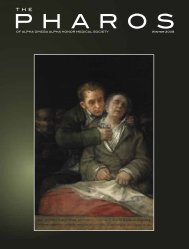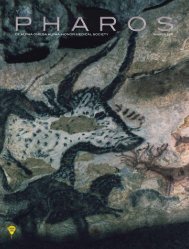4 - Alpha Omega Alpha
4 - Alpha Omega Alpha
4 - Alpha Omega Alpha
Create successful ePaper yourself
Turn your PDF publications into a flip-book with our unique Google optimized e-Paper software.
Jesse D. Woodard<br />
arat’s terror<br />
The author (AΩA, University of South Carolina, 2008) is<br />
a member of the Class of 2009 at the University of South<br />
Carolina School of Medicine. This essay won first prize in<br />
the 2008 <strong>Alpha</strong> <strong>Omega</strong> <strong>Alpha</strong> Helen H. Glaser Student<br />
Essay competition.<br />
When the prominent French revolutionary Joseph-<br />
Emmanuel Sieyes was asked what role he had<br />
during the French Revolution, he responded “J’ai<br />
vecu.” (“I survived.”) Thousands could not make that claim<br />
during the tumultuous decade from 1789 through 1799. The<br />
period was marked by fear, intrigue, and violence, and no life<br />
more closely paralleled the revolution than that of Jean-Paul<br />
Marat. During a decade of hostility he was L’Ami du Peuple<br />
(The Friend of the People), and even as his cries of Liberté,<br />
égalité, fraternité! rang through the streets of Paris, Marat’s<br />
assassination in 1793 showed that history is less a triumph of<br />
ideology than a series of tragic human atrocities.<br />
Marat, in his own time, was known as a madman, a fanatical<br />
demagogue, and the murderer of thousands. A mysterious<br />
skin disease earned him the stigma of a leper, but he is also<br />
remembered as a doctor, a frustrated scientist, and the subject<br />
of the period’s most memorable painting. The scene of<br />
his death in 1793 was immortalized in Jacques-Louis David’s<br />
masterpiece Death of Marat. The indelible depiction shows<br />
a Christ-like Marat lying dead in his bath, the evidence of his<br />
murder in plain view. Upon its completion, the painting was<br />
carried through the streets of Paris in tribute and Marat was<br />
worshipped as a god.<br />
Joseph Boze (1744–1826): Jean Paul Marat (1744–1789). French<br />
revolutionary. 1793. Painting.<br />
Location: Musée de la Ville de Paris, Musée Carnavalet, Paris, France. Photo credit: Alfredo<br />
Dagli Orti, Bildarchiv Pressicher Kulturbesitz/Art Resource, NY.<br />
The Pharos/Spring 2009 17














